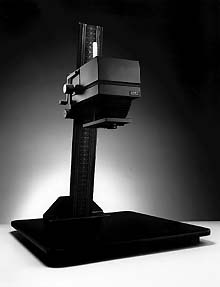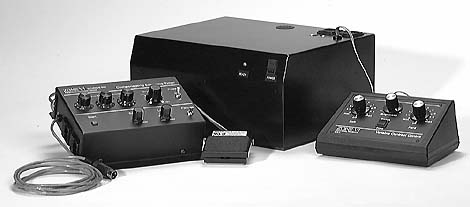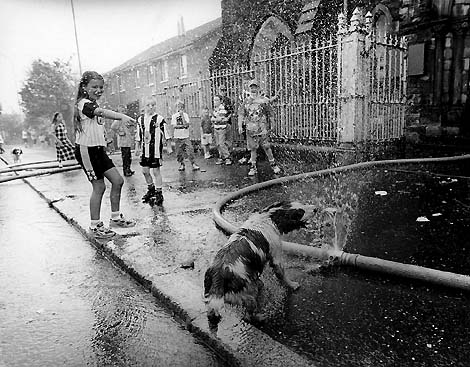

However, things don't stand still and most paper manufacturers have ceased, or drastically reduced the production of graded photographic paper to replaced it with multi-grade paper. Whilst this may be considered progress in many ways, and there are many printers who would not agree, I mourned the passing of graded paper because cold cathode enlargers and multi-grade paper just do not mix. Consequently, for the past two years my ancient cold cathode enlarger has stood idle except for those times that I have had to flash paper to control the contrast. Yes, such old techniques are still used even though I have multi grade paper which offers the benefit of split grade printing.
Many years ago the aforementioned Fred Picker started a photographic company which he named Zone VI with the aim to teach photography through workshops, and to develop high quality photographic equipment. The Zone VI Cold Cathode Variable Contrast Enlarger promises to be his most significant creation. KJP have supplied me with one of the first Zone VI enlargers imported to carry out a comprehensive test, so I again disappeared into my little darkened room filled with anticipation at the prospect of again using a cold cathode enlarger.

The Zone VI Cold Cathode Variable Contrast Enlarger will accommodate formats from 35mm to 5 x 7" and is designed to be as vibration-free as possible with a column formed from custom made extrusion. The sloping column has a large L-bracket which provides the mounting point to either the baseboard or the wall.
The height adjustment is gear driven onto four column-mounted tracks and the focusing movement is controlled by spring loaded self-adjusting focusing gears. Consequently, all movements are smooth and precise. The negative carriers are all glassless and of simple but functional design. There are no problems with negatives popping during exposure and causing unsharp prints because of the cold light source. The lens panel can be easily fitted on to the three small bolts protruding from the bottom of the head.

The Zone VI light source (back) with timer and footswitch (left) and contrast control unit (right)
The Zone VI cold cathode head incorporates a new concept in variable contrast enlargers in that it has two tubes, one blue for the hard grades and one green for the soft grades. This principle has been used in halogen lamp heads, but as far as I know never before in a cold cathode system. The head is connected to a control box which incorporates controls for each tube, a brightness control and a timer/focus switch.
The Compensating Timer does not stabilise the voltage to the lamphead; it constantly monitors the lamp brightness and compensates accordingly. If the lamphead increases or decreases in brightness, the timer automatically adjusts the exposure. Exposures can be timed from 0.1 to 99.9 seconds.
The timer has a built-in metronome which can be switched on and off as required. If the head output changes, you hear a change in the speed of the beeps which signals that the time is being adjusted to compensate. A brightness control allows for a change in printing time without changing the lens aperture.
Another most desirable feature is the drydown facility which allows for a reduction in the print exposure of up to 15 per cent to be programmed in to compensate for the difference between the appearance of a wet and a dry print.

A print made from a 35mm negative, using a 15 per cent drydown factor (Falls Road, Belfast)
Focusing is very precise and there are focusing knobs on both sides of the head, making it easy for those who wish to use the left hand for that function, a point that many manufacturers forget.
I have always maintained that multi grade heads should be adjustable in order that the printer can satisfactorily use different papers and get optimum results from them all.
Another point is that when paper manufacturers change their paper specification the filtration factors are also likely to change, which then means that the multi grade head must also be upgraded. This means that the enlarger has to be recalibrated in the factory or the printer has to make do with less than satisfactory results because of a change which is outside his control.
The Zone VI Variable Contrast Head eliminates all of those problems simply because you set the controls to your own specification. The control box has a control for each of the two tubes. They are not indexed with grades, but have values on a scale from A to H in addition to a minimum and maximum setting.
To get a desired grade or contrast you simply dial in values of soft and hard. The more hard that you dial in, the higher the contrast and so on. Consequently, you can determine the exact filtration required for any paper, and prepare a chart of the values which can be hung on the darkroom wall for future reference. I spoke to a Zone VI salesman in Chicago and he suggested that as a starting point equal values of hard and soft filtration would give me a grade two, and that I could work from there to determine the other grades.
Another approach is to match a print made on a known grade of a graded paper and use the filtration factors as a starting point. The combinations are numerous and the control is very precise and it does work.
Clearly, with so many options at hand you must decide on one way of working and use only that otherwise you will run the risk of falling into the grasshopper mentality and jump all over the place resulting in inconsistent results. I made prints on four different variable contrast papers using the same filtration factors and each produced a different contrast, which merely proves that enlargers have to be calibrated for each paper.
To test this feature I made 10 prints from the same negative using the same base exposure as well as various exposures for burning in and dodging. In addition I used split-grade printing and applied the drydown factor that I had determined for the paper that I was using.
All 10 prints were of the same density when they had been washed and dried. I also tested the drydown facility by making one print three times - one where no drydown factor was used and others with drydown factors of 10 per cent and 15 per cent. The finished prints clearly showed that the prints got progressively lighter dependent on the factor applied.
To use the drydown facility it is necessary to first carry out your own tests to determine the percentage drydown factor to apply for that paper, thereafter you decide when viewing the wet test strip which stripe on the test strip is to your liking, and dial in the predetermined factor. The timer then takes care of the exposure for you by automatically reducing the base exposure by the percentage that you dial in.
In my view the smoothness of the tonal range cannot be matched by any other light source and this, together with the use of multi-graded paper, offers endless possibilities to produce prints of the finest quality.
The degree of sophistication in both the variable contrast control box and the compensating timer belie the simplicity of operation although I have to say that I feel that the timer could be improved by the inclusion of an f-stop facility. Perhaps I feel that way as a result of the recent test that I carried out on the Stop Clock Timer. This is not a criticism of the Zone VI Compensating Timer, merely an observation.
The Zone VI Cold Cathode Variable Contrast Enlarger represents the best that technology has to offer in fine black and white enlargers. If you are searching for the ultimate in black and white enlargers then Calumet/KJP have provided it for you.
In my view the Zone VI Cold Cathode Variable Contrast Enlarger, whilst it is not cheap, represents the best that money can buy in darkroom equipment and will be, after all, a once in a lifetime purchase. To achieve the best in multi-grade, I would consider it an essential planned purchase for all serious black and white photographers, hand printers and fine art laboratories.